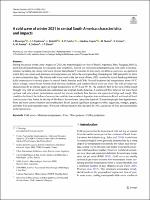Mostrar el registro sencillo del ítem
A cold wave of winter 2021 in central South America: characteristics and impacts
| dc.contributor.author | Marengo, J. | |
| dc.contributor.author | Espinoza, JC | |
| dc.contributor.author | Bettolli, L. | |
| dc.contributor.author | Cunha, A. P. | |
| dc.contributor.author | Molina-Carpio, J. | |
| dc.contributor.author | Skansi, M. | |
| dc.contributor.author | Correa, Kris | |
| dc.contributor.author | Ramos, A. M. | |
| dc.contributor.author | Salinas, R. | |
| dc.contributor.author | Sierra, J.-P. | |
| dc.date.accessioned | 2023-08-24T17:34:19Z | |
| dc.date.available | 2023-08-24T17:34:19Z | |
| dc.date.issued | 2023 | |
| dc.identifier.uri | https://hdl.handle.net/20.500.12542/2893 | |
| dc.description.abstract | During the austral winter (June–August) of 2021, the meteorological services of Brazil, Argentina, Peru, Paraguay, Bolivia, and Chile all issued forecasts for unusually cold conditions. Record-low minimum temperatures and cold spells were documented, including one strong cold wave episode that affected 5 countries. In this study, we define a cold wave as a period in which daily maximum and minimum air temperatures are below the corresponding climatological 10th percentile for three or more consecutive days. The intense cold wave event in the last week of June, 2021, resulted in record-breaking minimum daily temperatures in several places in central South America and Chile. Several locations had temperatures about 10 °C below average, central South America had freezing conditions, and southern Brazil even saw snow. The cold air surge was characterized by an intense upper-air trough located close to 35° S and 70° W. The southerly flow to the west of this trough brought very cold air northward into subtropical and tropical South America. A northward flow between the lower-level cyclonic and anticyclonic perturbations caused the intense southerly flow between the upper-level ridge and trough. This condition facilitated the inflow of near-surface cold air from southern Argentina into southeastern Brazil and tropical South America east of the Andes. In the city of São Paulo, the cold wave caused the death of 13 homeless people from hypothermia. Frost and snow across southern and southeastern Brazil caused significant damage to coffee, sugarcane, oranges, grapes, and other fruit and vegetable crops. Wine and coffee production fell, the latter by 30%, and prices of food and commodities in the region rose. | es_PE |
| dc.format | application/pdf | es_PE |
| dc.language.iso | spa | es_PE |
| dc.publisher | Springer | es_PE |
| dc.relation.uri | https://link.springer.com/article/10.1007/s00382-023-06701-1 | es_PE |
| dc.rights | info:eu-repo/semantics/openAccess | es_PE |
| dc.rights | Atribución-NoComercial-SinDerivadas 3.0 Estados Unidos de América | * |
| dc.rights.uri | http://creativecommons.org/licenses/by-nc-nd/3.0/us/ | * |
| dc.source | Repositorio Institucional - SENAMHI | es_PE |
| dc.source | Servicio Nacional de Meteorología e Hidrología del Perú | es_PE |
| dc.subject | Cold Wave | es_PE |
| dc.subject | Cold Air | es_PE |
| dc.subject | Freezing | es_PE |
| dc.subject | Temperatura del Aire | es_PE |
| dc.title | A cold wave of winter 2021 in central South America: characteristics and impacts | es_PE |
| dc.type | info:eu-repo/semantics/article | es_PE |
| dc.identifier.doi | https://doi.org/10.1007/s00382-023-06701-1 | |
| dc.identifier.journal | Dinámica Climática | |
| dc.subject.ocde | https://purl.org/pe-repo/ocde/ford#1.05.09 | es_PE |
| dc.identifier.url | https://hdl.handle.net/20.500.12542/2893 |
Ficheros en el ítem
Este ítem aparece en la(s) siguiente(s) colección(es)
-
Artículo científico [170]









